We descended the steep trail from the parking lot into the Barron River valley and came into a grove of pine trees with waist-thick trunks; their roots fanned out more than 20′ and intertwined above the shallow soil. At the river’s edge was a clearing carpeted in russet pine needles. The banks were lined with rounded barrel-sized boulders, and rocks just below the surface of the water had a copper-colored glow. Where the 50′-wide river was deepest it ran black.
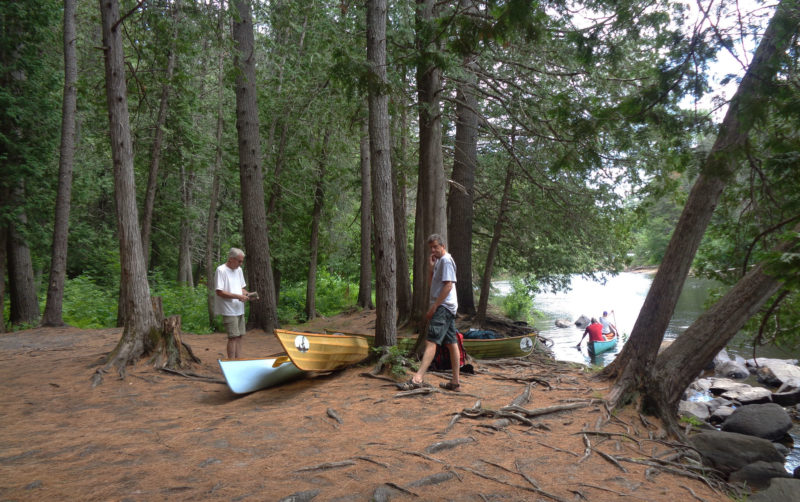 Photographs by the author
Photographs by the authorAfter carrying the canoes down from the long, steep path from the Brigham Lake parking lot, Phil and Rob paused for a rest before launching onto the Barron River. Two paddlers who preceded us are just getting underway.
The sun was high overhead and the heat of the day was peaking. Sweat beaded on my brow, but waiting for us was a soothing breeze on the Barron River. I was headed, with Rob and Phil, my canoe buddies for many years, to a part of Ontario’s Algonquin Provincial Park known as Barron Canyon, where granite cliffs stretch 300’ above the river.
All of us, now in our 60s, preferred to use my lightweight solo canoes (30 lbs) that I call Wee Bonnies. Rob and I used the skin-on-frame versions, while Phil always has dibs on the one I strip-built using light blue insulation foam.
Launching into the shallow, gentle current of the Barron River, we slid slowly downstream in clear, cool water over black, white, and orange granite stones the size of golf balls.
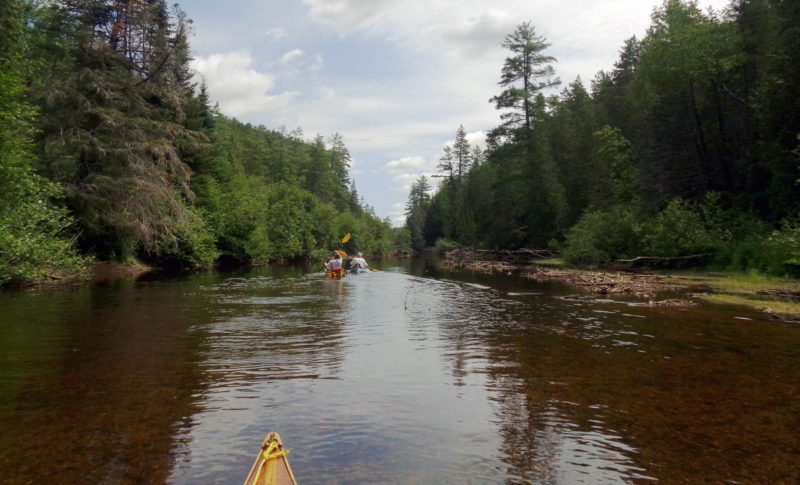
As we headed downstream over a shallow stretch of the river, we had to be careful to watch for submerged log debris and rocks lurking just below the surface.
Phil took the lead, Rob followed, and I was at the end, making sure to avoid any sunken logs or boulders that were just under the surface of the shallow river here. The banks were high and thick with white and red pine, and as the land rose up around us, we paddled by sections of crumbled cliffs and boulders separated by stands of trees. Pickerelweed with its spikes of purple flowers was thick along both sides of the river, and log debris was everywhere.
The river widened abruptly at the entrance to a small lake, and the rippled sand beneath us dimmed as the water gradually deepened. Brigham Lake is 200 yards across and twice as long and surrounded with pine and fir. We paddled to the south side of the lake and carefully picked our way through barely submerged shoreside rocks to a clearing in the woods.
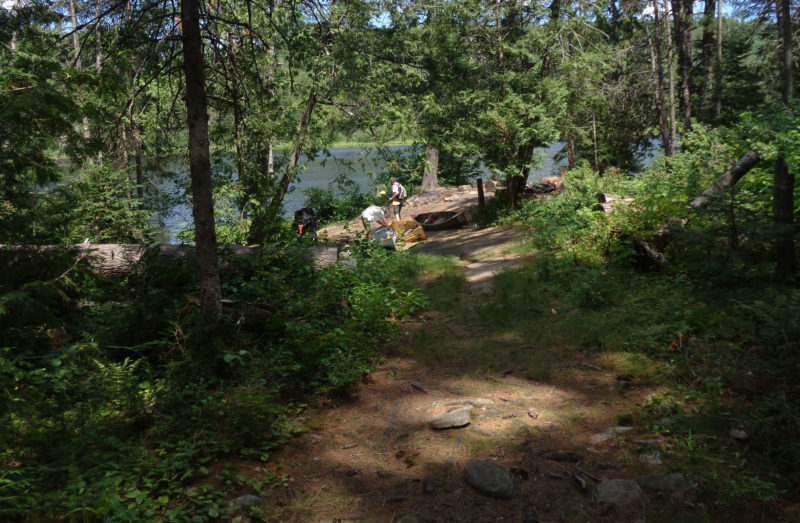
To prepare the canoes for portaging from Brigham Lake to Opalescence Lake we flipped the seats up so the yokes on the ends of the seats were ready for the carry. The trail was steep and rocky so we carried the canoes and packs in separate trips.
A campsite there had a stone-ring fire pit and log rounds for seats, but we were here not to stay but to portage to Opalescent Lake. The carry would be a challenge, as it rose about 150 feet over a distance of 800 yards. The path was well defined and easy to follow but strewn with ankle-twisting rocks and roots. It crossed steep-sided valleys and skirted steep rocky drop-offs, so we decided to carry our gear and canoes in two trips. If the portage was less rough, we would have chosen to do a single carry. We had plenty of time, so two trips it was.
The three of us picked up our packs and set off on the first crossing along the sun-dappled path, winding through the thick bush of pine. While I could see clearly ahead over 50’, I kept my focus downward, and stepped gingerly over rocks and roots, sometimes hidden by a thick layer of dried pine needles. We maneuvered down some rock steps, being careful not to lose our footing on the uneven ground and tumble down a rocky granite slope. We passed through a valley and crossed a small creek on a narrow bridge made of four long, springy 2x6s. In the lowlands around the creek, swarms of mosquitoes attacked us and we picked up our pace. As we got close to the end of the portage, we could see the sun sparkling on the water through the trees. It was a welcome sight because our packs, fully laden with gear and provisions for four days, were at their heaviest.
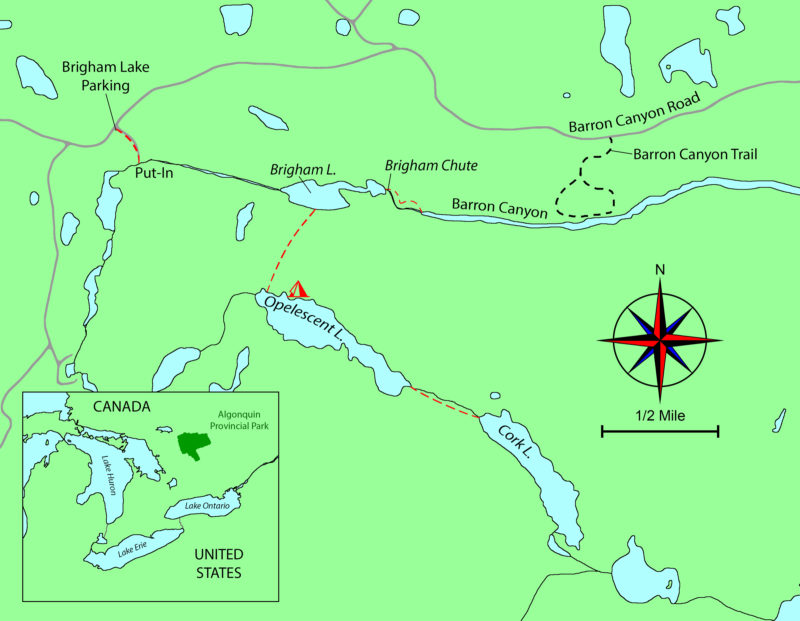 Roger Siebert
Roger Siebert.
I set my pack down at the end of the portage, scratched my legs and arms, and then reached into the front pouch of my pack to pull out a bottle of bug spray. I hadn’t applied enough repellent to deter the little blood-sucking pests; I’d be better protected for the return trip.
Phil and Rob had already headed back and I could hear them in the distance, cursing the mosquitoes. Well slathered with spray, I hurried back over the rocky trail to catch up. Back at the Brigham Lake clearing, Rob flipped his canoe onto his shoulders and took the lead, with Phil close behind him. I brought up the rear again, hoping the mosquitoes would have had their fill from them and leave me be.
The third walk on the trail was easier because the canoes were lighter than our packed gear, and the mosquitoes left me alone, but the trickles of sweat running down my face seemed to attract deerflies. There was no cooling breeze making its way through the thick bush of pine, spruce, and fir, and the back of my T-shirt was drenched and sticking to my skin.
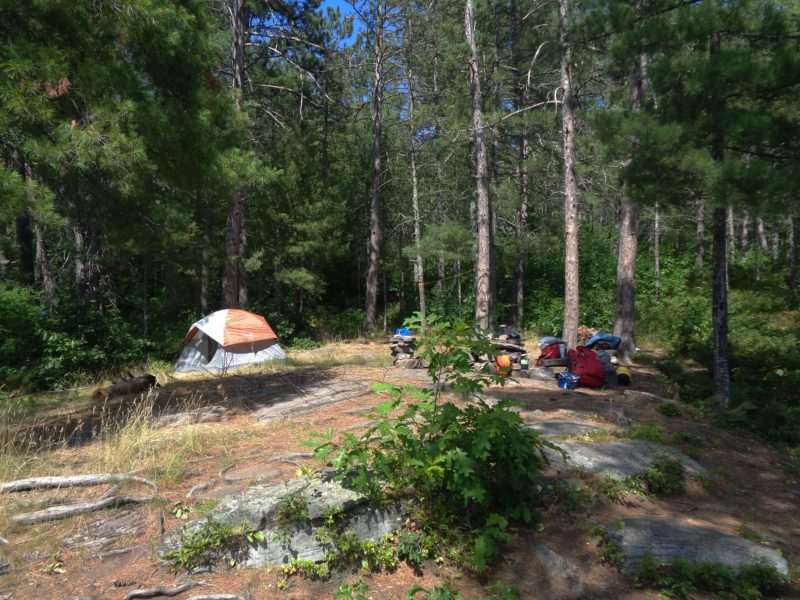
We set up our base at the Opalescence Lake camp site where we would stay for the next two days and do day trips. There was still some unpacking to do but but a refreshing swim came first.
I rejoined Phil and Rob at the end of the portage, and gently swung my canoe down on a patch of the hard-packed ground cushioned with pine needles. A soft cool breeze skimming across Opalescent Lake provided some relief on that hot day in July. The irregular chain of rocks that had dotted the portage carried on into the lake, making it difficult to find enough space to launch our canoes. The clear water, its dark-blue surface dotted with bright green lily pads, was breathtakingly beautiful and indeed opalescent.
The narrow lake, running ¾ mile from east to west, was hemmed in by red and white pine, cedar and spruce, and scattered maples and birch. We walked out onto a low rock ledge at the edge of the lake and set our canoes in the still water. After loading the packs aboard, we eased into our seats and pushed off.
Just around a bend from the launch, we glided up to a granite ledge on a blunt point of land where pale, shin-high grass surrounded bald outcroppings of bedrock. Working together, the three of us quickly carried the canoes up past the ledge and set them on a tracery of roots covering the nearly flat ground. In 2013 we had camped here in the sun-drenched clearing, a dozen yards wide. Since then a tree that had provided shade had been snapped in half, perhaps in a heavy wind storm a few years ago.
Rob pointed out to me that his canoe’s seat had started to split, as the synthetic cane weaving had finally succumbed to the sunlight after four years of use. I would do some patching later.
Since we’d been here before, I knew just where to hang my hammock and Phil and Rob knew where to pitch their tent. The bedrock, of course, made it impossible to set tent pegs, so we weighted them down with rocks. My hammock was strung between two large pines where the bank started to slope down to the lake, so I’d have a good view of both the lake and sky.
With our camp set up, we could take advantage of the clear lake water just a few yards away. We dove off the rock ledge, swam out about a quarter of the way across the lake, and bobbed around, enjoying the refreshing feel of cool water below the warm surface layer.
As we climbed out of the water, Phil noticed blueberry bushes at the edge of the clearing. The berries were so sweet, it was hard to save some for breakfast.
Rob, Phil, and I have a tradition of having steak for dinner on our first night at camp. We had brought a frozen, precooked meal of steak, potatoes, and veggies. It had thawed during the day and all we had to do was to warm it up on our camp stove. For dessert, I’d brought a bar of dark chocolate.
With supper over, dishes done, we needed to pack all the food in a bag and hang it in a secure location outside our camp beyond the reach of mice, chipmunks, raccoons, and bears. We found a tall dead tree about 100’ to the east and Phil and I took turns trying to throw the rope, with a small rock tied to one end, up over the branch about 20′ up. I missed, but Phil did it on his second try. We hoisted the bag and headed back to camp. We made a small fire in the campsite’s fire pit, a ring of flat granite rocks piled in several tiers. Flickering flames spread easily across the dry dead branches Rob had gathered. Watching the flames was calming, and, tuckered out, we soon headed for our sleeping bags. Stargazing would have to wait. We were in bed by 10 o’clock, but I couldn’t fall asleep. Bullfrogs seemed intent on singing all night, and one was just 10′ from my hammock. Every 40 seconds he let out about four or five deep “ribbits.” I fell asleep at about 2 a.m., only to be awakened by two loons three hours later. Their haunting calls echoed off the far shore, making it sound like there were more of them.
After a breakfast of oatmeal and coffee, I worked on the seat on Rob’s canoe. I always carry some 1/8″ nylon cord and it worked for reweaving the damaged half of the seat. With a foam cushion added, it would be almost as good as new, but feeling somewhat guilty that I hadn’t replaced that old cane in the spring, I let Rob use my green skin-on-frame canoe and I would take his.
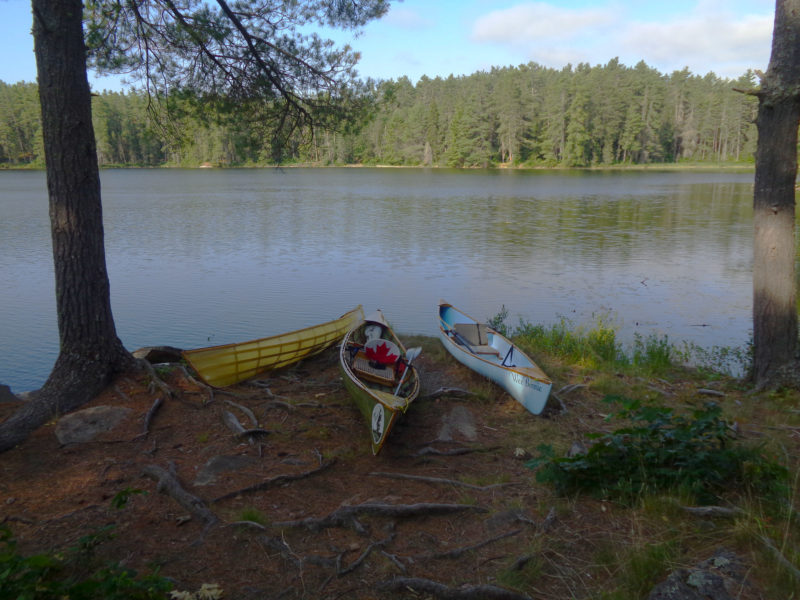
A light morning breeze ruffled the lake just before we launched for our day trip to explore Cork Lake.
Our plan was to go for a day trip to Cork Lake, east of Opalescent Lake via a 750-yard portage. We paddled slowly down the far shore of Opalescent Lake, taking our time, paddling as close to shore as possible to peer into the woods and enjoy the scenery. We passed a campsite on a rocky point; some trees there had been toppled by a small tornado that had passed through in July 2013. Massive pines lay on their sides, root structures upright like a giant saucer on edge.
The portage to Cork Lake was as reasonable as a portage through the bush could be, and we were carrying only light daypacks with our canoes so we only had to walk it once. It didn’t take us long to reach the shore of the lake.
Cork Lake had only three campsites, and only one was occupied that morning. The water was crystal clear, but the decaying debris on the bottom made it look an inky black. We hugged the shore and saw a few loons. The shallows along the shore were cluttered with underwater logs and a lot of rock ledges, but the water was so clear they were easily seen and avoided. One ledge was a massive dome of bright, gold-colored granite that loomed just 6″ under the water.
We took our time, circled some boulders, and squeezed our canoes in behind others.
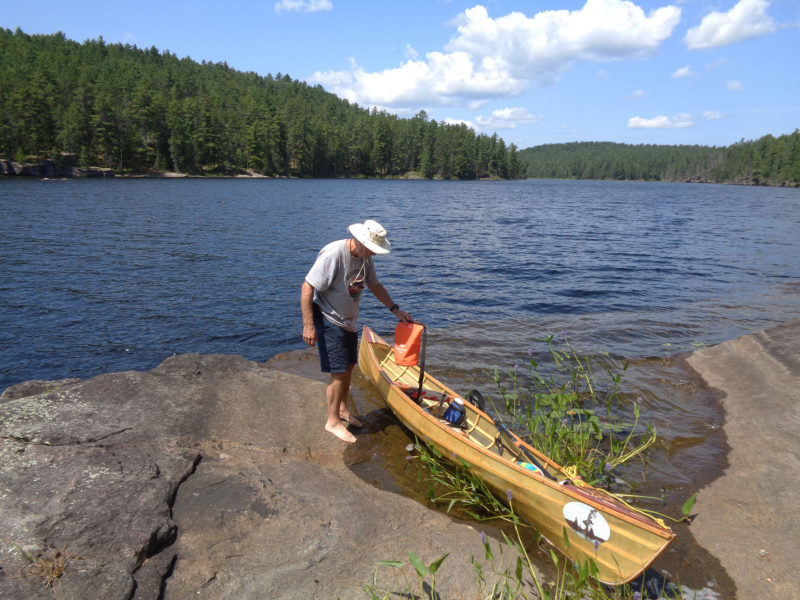
When we stopped for lunch on Cork Lake, I pulled into a shallow, very slippery rock cove and let the north wind hold my canoe in place while we ate.
Heading north along the eastern shore, we stopped about halfway for lunch at a flat, scrub-covered rock ledge protruding out from shore. Phil and Rob pulled their canoes out of the water to keep the northerly, now steady breeze from sweeping the canoes away. I circled around to a cove on the north side of the landing, where the wind would hold my canoe mostly afloat over a smooth shelf of rock. We sat in silence, taking in the warm sun and eating lunch. Rob and I dove into the cool, clear water, swam well out from shore, and just floated, taking relief from another hot and humid day.
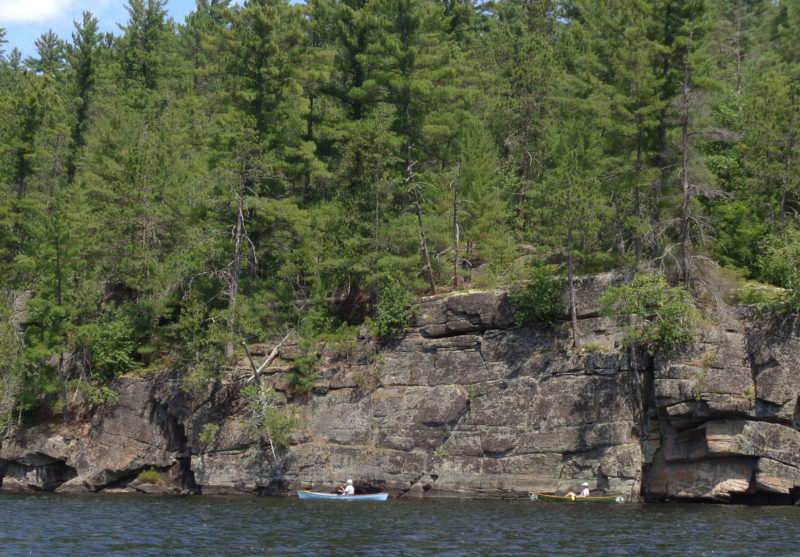
Phil and Rob paddled close enough to touch the cliff that bordered the east shore of Cork Lake. The vertical rock face extended well under water.
We continued our loop of the lake and paddled up the east side to massive cliffs of multicolored granite that towered over it. Orange lichen made the cliffs look as if they were spray-painted.
We made the carry back to Opalescent Lake and just as I stepped into my canoe, I slipped and dropped right on the back rest, snapping it from the thwart. I couldn’t paddle with my back up against the thwart, so I used a water sandal as a cushion and paddled gently back to camp. I rummaged through my pack to see what odds and ends I could use for repairs. I had thrown in a couple of bicycle inner-tube strips as general-purpose bungee cords. It wasn’t a pretty repair, but it worked to hold the seat back on the thwart.
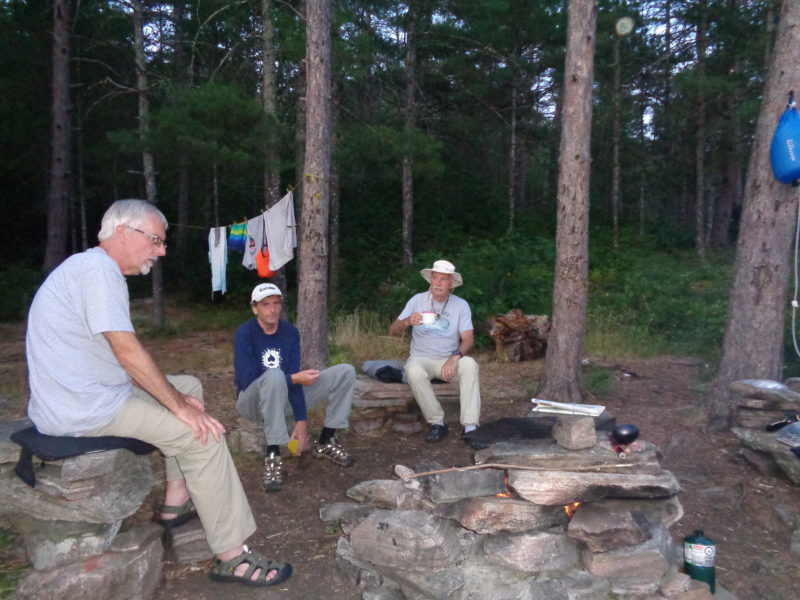
Back at the Opalescent Lake camp after a day of paddling, Phil, at left, gazed at the small fire in the fire pit. Rob, center, and I relaxed with a cool drink.
As the evening dimmed the perfectly clear sky, Venus appeared, followed by the brightest stars one by one. Soon the sky was filled with constellations and streaked by shooting stars traced by satellites. When we hit the hay, it was nearly midnight with so many bullfrogs croaking that it sounded like white noise. Loons again woke me up early.
The morning was hot and humid even as we were getting our daypacks ready; we launched and set out to explore Barron Canyon. Three shadow-dappled portages through the woods, a 350-yard paddle across tiny Brigham Lake, and we were back at the Barron River 650 yards downstream from where we’d first launched two days before and very close to the canyon’s west upstream end. We launched the canoes into the clear shallow water where the river was running fast over a bed of tumbled granite stones. We slowly traveled downstream—sometimes lightly paddling, sometimes just drifting—and as the embankments flanking the river rose over us, the water deepened and the current slowed. Hemmed in by rough boulders, the river flowed past the stands of white pine, then towering cliffs where trees had taken root in small crevices in the rock and grown tall with their backs up against the vertical sides of the canyon walls. The cliffs rose over 300’ high and were streaked chalky white and sooty black with minerals leached by rainwater, and the rest of the rock was stained cinnamon brown or draped with moss; only a few places showed the rock’s real color. We paddled beneath outcroppings of granite that were cantilevered over the river.
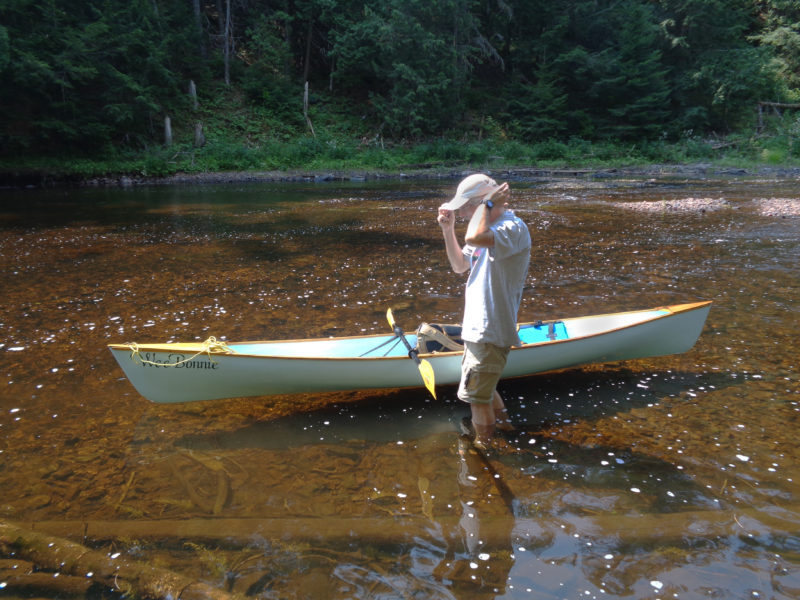
Phil got ready to step into his Wee Bonnie for the final leg into the Barron Canyon. The water was so clear it made the canoe look as if it were floating in air.
About a mile or two downriver—I’d lost track of how far we had come—we found what seemed to be the only accessible spot to pull up our canoes and have a bit of lunch. We climbed up into a secluded grove of widely spaced slender red pines, then sat and looked out at the slightly rippled narrow river and at the pine-covered steep rocky embankments. A few other canoeists paddled by.
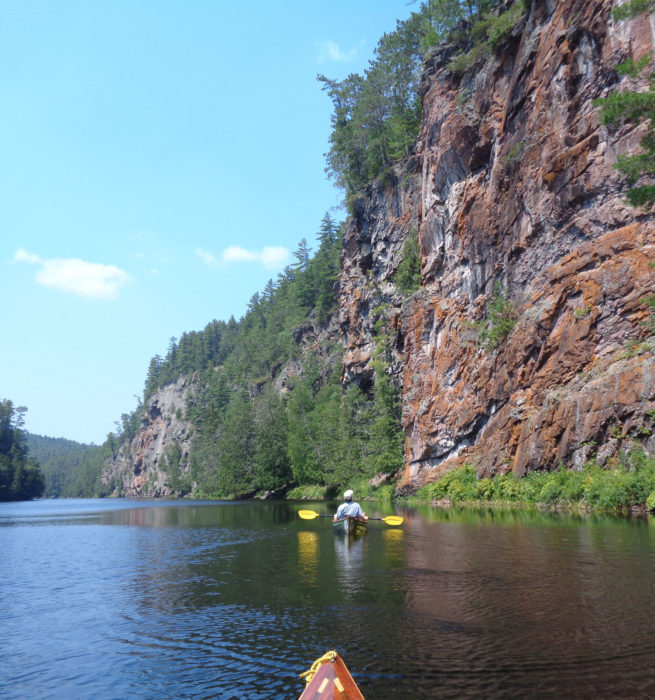
Rob gazed up at one of the massive multi-colored granite cliffs that stretch up over 300’ high. Hikers could peer back down from a trail at the top.
It was time to start the long trip back, so we launched and headed slowly upstream the mile or so back to the portage we had come through a couple of hours ago. A great blue heron flew ahead of us, landed a short distance away, only to fly ahead again at our approach. A beaver swam across the river in front of us; the heron landed once again and finally just waited for us to get by.
As the water grew shallow approaching the portage, we got out of our canoes and walked over the pebbled bottom, with the cool water lightly flowing over our feet. We pulled the boats upstream 60′ or so. A couple of hikers were moseying along the river bed in the ankle-deep water as if they were strolling in the park.
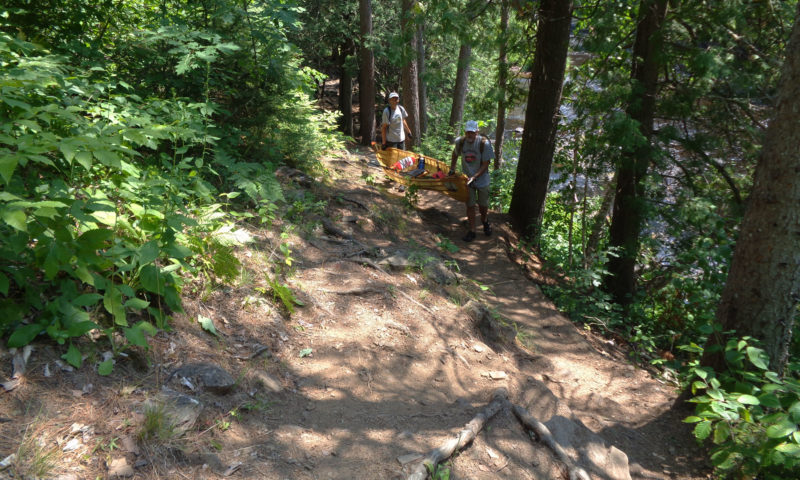
Phil and Rob shared the carry of one of the canoes as they hiked up the steep, rocky portage trail as we headed back toward Brigham Lake
The portage was short and would now be a little easier with our lightened packs, though rough with lots of roots and rocks to carefully step over. We carried up the initial steep slope of the portage one canoe at a time. Once at the top the path was now level but high up from the river bed. I chose to carry my own canoe with my lunch bag strapped to the thwart. Phil and Rob chose to carry both their canoes parallel to each other, holding their daypacks, with one person at the front and one at the back. We stepped along a steep and narrow path with the Barron River to our left and barely visible through the trees. Halfway along the portage, we took a short break at the narrow falls and rapids known as the Brigham Chute. The water there crashed down over a small waterfall and swirled around in side-streams to get through all the rocks.
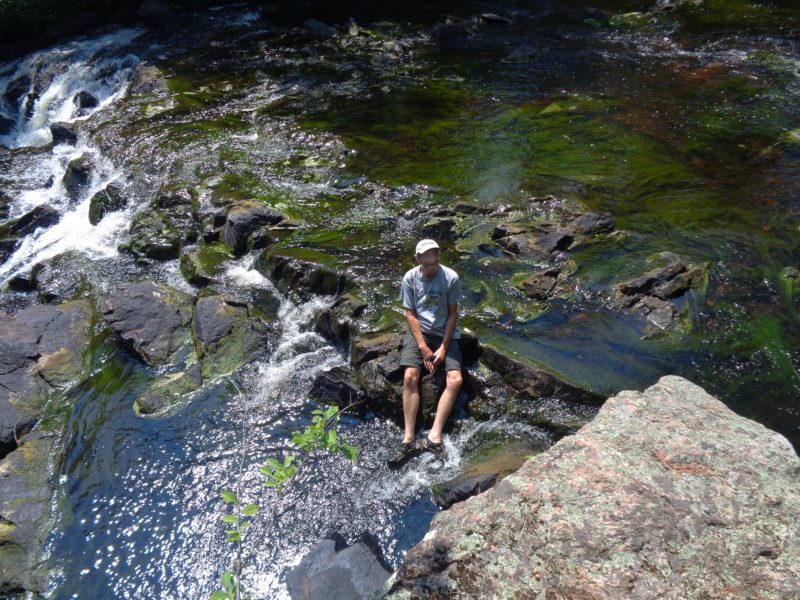
Stopping for a break at the Brigham Chute, Rob decided to climb down and sit out in the center of the stream. Phil and I thought the climb down to be too precarious and remained up on the embankment.
From the Chute it was only a short walk to the river, where we launched, paddled a short distance, then made the100-yard portage back to Brigham Lake. Then the longer 800-yard portage uphill put us back into Opalescent Lake, and a paddle around the corner put us back in camp.
That night we were beat and all in bed before 9:30. The evening was hot and humid, and I had the fly of my hammock flipped back to catch whatever breeze there might be. I gazed up through the bug netting at the evening sky. I could clearly see the stars and even the glowing band of the Milky Way, and soon slipped into a deep sleep.
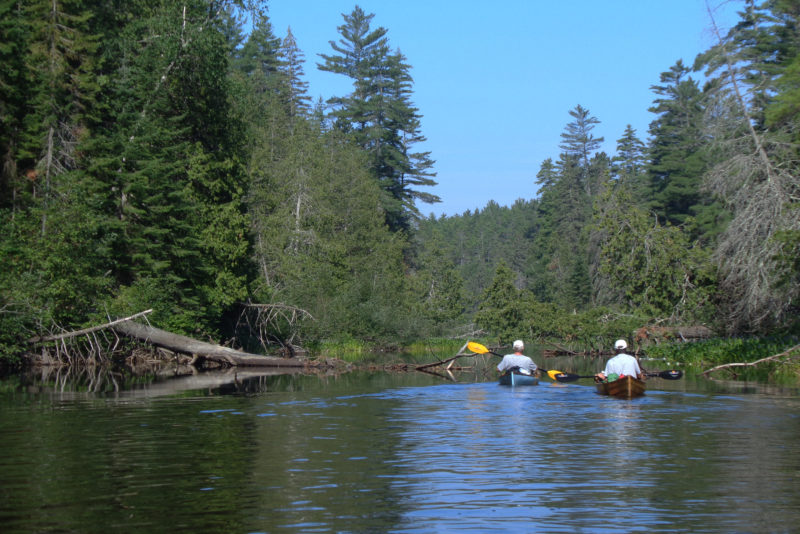
Heading back up stream on the Barron River, we approached our launching point from a few days prior. The solo canoes could easily maneuver in and around any debris we encountered.
We were up the final morning shortly after 6 a.m. We had our breakfast, took a quick swim, and then broke camp and retraced the route we had come three days earlier via a short paddle, again the 800-yard portage into Brigham Lake, and back into the Barron River, but this time heading northwest upstream 3/4 mile, with a final carry up the hill to the parking lot. It took us a couple of hours to get back to the cars and packed up for home.
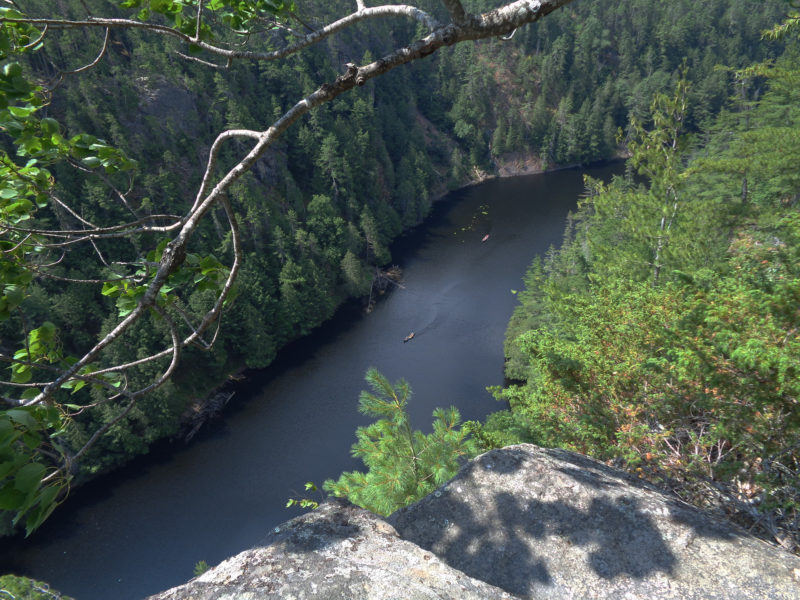
Gazing down from a dizzying height on top of the Barron Canyon trail we watched canoes coming down stream through the canyon.
It was still early in the day, so we drove the short distance to the Barron Canyon Trail, parked, and hiked up the steep, well-worn trail leading to the top of the canyon. I looked down over the edge at the meandering river. In the distance, three canoes, almost invisibly small, traveled downstream and vanished around a wooded bend.![]()
Phil Boyer retired in 2017 after working 38 years in R&D in the telecommunications industry. He now keeps busy teaching karate at two local clubs and building boats. He has been around boats his whole life, starting with paddling as a kid. At age 11 he built a sailing pram with a bit of help from his father. In 2006 he began building solo canoes and now has four of them, featured in the August 2019 issue. Phil’s interest turned to building SOL CANADA, his solar-electric boat, in 2015. His next build will be a solar-electric version of the Power Cat he read about in the March 2016 issue of Small Boats Magazine.
If you have an interesting story to tell about your adventures with a small boat, please email us a brief outline and a few photos.
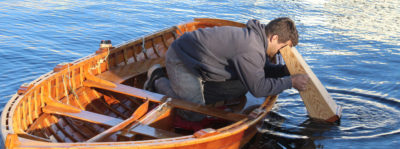


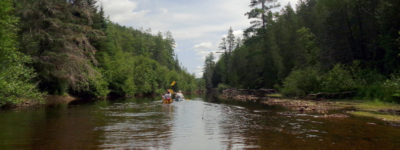
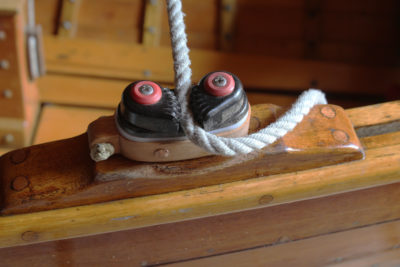
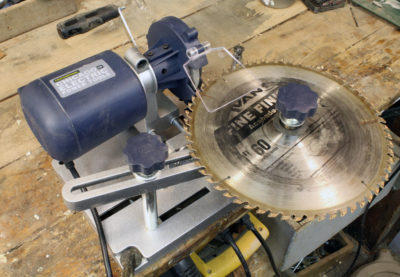
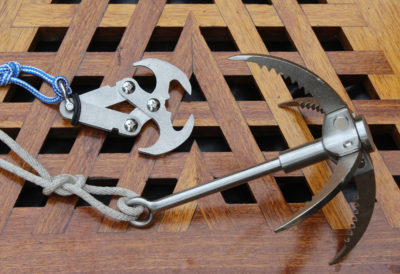

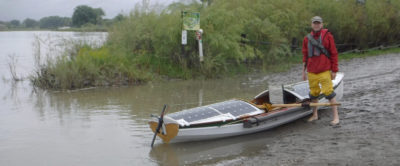

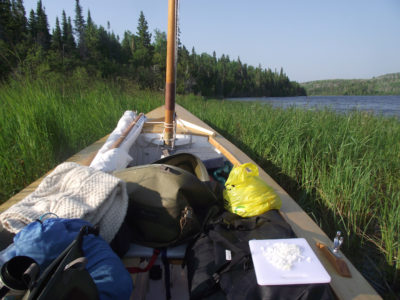
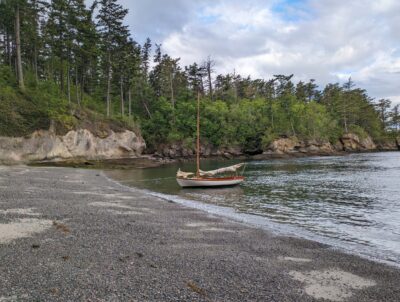
Wonderful memories come back. Living now in Australia; watching this makes me homesick!
In my younger years, I made two trips to the park, and both make up some of my most memorable adventures—alone with a few friends, open nature, meeting a moose feeding in a slow river, cliffs and rapids, but also ‘sailing’ in a canoe down long lakes, and super-clear night skies. (OK, forgetting any cooking oil and frying fresh fish in peanut butter was less magnificat, but still memorable.) There are many great loops, and it sounds like you can still be alone, which is so rare these days.
Hi Leo and Grant,
I am fortunate to live within a few hours of this fantastic park. We sometimes take it for granted until we meet canoe trippers from all over the world who make a point of traveling to Canada to go on a trip into Algonquin Provincial Park.